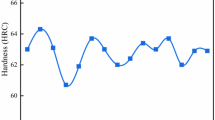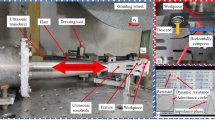Abstract
Ultra-high strength steel was increasingly utilized in aero-engine transmission systems due to its exceptional hardness and strength. However, the high hardness and wear resistance of this material could accelerate the wear rate of alumina wheels, ultimately reducing surface finish and geometric accuracy during machining processes. In this case, the ultrasonic vibration-assisted grinding (UVAG) process was proposed to achieve the high performance machining requirements. In this paper, comparative trials were conducted to evaluate wheel wear when grinding ultra-high strength steels using conventional grinding (CG) and UVAG processes with different alumina abrasive wheels, including white alumina (WA) and microcrystalline alumina (MA) wheels. Characterizations of wear performances, such as grinding forces, force ratio, surface morphology of alumina wheel, wear properties of abrasive grains, and ground surface morphology, were elaborated. Results indicate that the contact-separation characteristics of UVAG can modify the trajectory and mode of abrasive cutting workpiece material, resulting in variations in grinding force and force ratio during the process of alumina wheel wear. The morphology evolution of grinding wheel during wear is modified by UVAG, leading to a reduction in severe adhesions and agglomerated wear chips. UVAG induces more abrasive grain fracture in the grinding process, generates additional grinding edges, and sustains the grinding performance of both alumina grains and wheels. Meantime, in comparison with WA wheels, MA wheels do not experience chip clogging or abrasive macro-fracture after prolonged UVAG grinding. This is attributable to the hardness and self-sharpening properties of MA grains, which produce sharper grinding edges, reduce grinding force and chip width, and prevent wear chips from adhering to or accumulating in pores.








Similar content being viewed by others
Data availability
All data generated or analyzed during this study are included in the present article.
References
Zhao WD, Liu DX, Liu J, Zhang XH, Zhang H, Zhang RX, Dong YL, Chang Y (2021) Effect of lubricants on microstructure and properties of metal abrasive tools via wet molding. Adv Eng Mater 23(3):2001203
Taylor CM, Díaz F, Alegre R, Khan T, Arrazola P, Griffin J, Turner S (2022) Investigating the performance of 410, PH13-8Mo and 300M steels in a turning process with a focus on surface finish. Mater Des 195:109062
Waller MD, McIntyre SM, Koudela KL (2020) Composite materials for hybrid aerospace gears. J Am Helicopter Soc 65(4):1–11
Guo CS, Zhang CM, Bai HQ, Zhao ZX (2019) Influence of milling parameters on milling performance of 300M ultra high strength steel. IOP Conf Ser: Mater Sci Eng 493:012065
Miao Q, Ding WF, Gu YL, Xu JH (2019) Comparative investigation on wear behavior of brown alumina and microcrystalline alumina abrasive wheels during creep feed grinding of different nickel-based superalloys. Wear 426–427:1624–1634
Zhou YG, Gong YD, Cai M, Zhu ZX, Gao Q, Wen XL (2017) Study on dynamic recrystallization-based microstructure evolution mechanism of 40Cr during strengthening grinding. J Mater Process Technol 309:117754
Li BK, Miao Q, Li M, Zhang X, Ding WF (2020) An investigation on machined surface quality and tool wear during creep feed grinding of powder metallurgy nickel-based superalloy FGH96 with alumina abrasive wheels. Adv Manuf 8(2):160–176
Li M, Yin JF, Che LB, Ding WF, Xu JH (2022) Influence of alumina abrasive tool wear on ground surface characteristics and corrosion properties of K444 nickel-based superalloy. Chin J Aeronaut 35(6):339–351
Dang JQ, Zhang H, An QL, Ming WW, Chen M (2022) Feasibility study of creep feed grinding of 300M steel with zirconium corundum wheel. Chin J Aeronaut 35(3):565–578
Dang JQ, Zhang H, An QL, Ming WW, Chen M (2021) Surface modification of ultrahigh strength 300M steel under supercritical carbon dioxide (scCO2)-assisted grinding process. J Manuf Process 61:1–14
Yao YL, Sun C, Xiu SC, Hong Y, Hou ZZ, Zou XN (2022) Study on dynamic recrystallization-based microstructure evolution mechanism of 40Cr during strengthening grinding. J Mater Process Technol 123(5–6):117754
Dong GJ, Wang L, Gao SD (2022) Grinding force model for rotary ultrasonic grinding of TiBw mesh reinforced titanium matrix composites. Diamond Abrasives Eng 42(1):97–103
Zhu XM, Liu Y, Zhang JH, Wang K, Kong KK (2022) Ultrasonic-assisted electrochemical drill-grinding of small holes with high-quality. J Adv Res 23:151–161
Zhang HT, Bao Y, Yang F, Sun HQ, Dong ZG, Kang RK (2022) Ultrasonic assisted helical grinding of SiCf/SiC ceramic matrix composites. Diamond Abrasives Eng 42(1):81–87
Zhang K, Yin Z, Dai CW, Miao Q, Cheng QH (2022) Undeformed chip thickness characteristics in grain-workpiece contact zone in ultrasonic vibration assisted grinding. Diamond Abrasives Eng 42(1):19–23
Wang JJ, Zhang JF, Feng PF, Guo P (2018) Experimental and theoretical investigation on critical cutting force in rotary ultrasonic drilling of brittle materials and composites. Int J Mech Sci 135:555–564
Bhaduri D, Soo SL, Aspinwall DK, Novovic D, Bohr S, Harden P, Webster JA (2017) Ultrasonic assisted creep feed grinding of gamma titanium aluminide using conventional and super abrasive wheels. CIRP Ann – Manuf Techonol 66(1):341–344
Bhaduri D, Soo SL, Novovic D, Aspinwall DK, Harden P, Waterhouse C, Bohr S, Mathieson AC, Lucas M (2013) Ultrasonic assisted creep feed grinding of Inconel 718. Procedia CIRP 6:615–620
Abhimanyu C, Ashwani S, Akash SA, Mohd ZKY, Meghanshu V (2022) Modeling and simulation study of dry ultrasonic vibration-assisted grinding of tool steel with single alumina abrasive grit. J Manuf Sci Eng 144(11):111001
Abhimanyu C, Mohd ZKY, Meghanshu V (2021) Grindability study of hard to cut AISI D2 steel upon ultrasonic vibration-assisted dry grinding, Proceedings of the Institution of Mechanical Engineers. Part E J Proc Mech Eng 236(3):915–925
Lei XF, Xiang DH, Peng PC, Niu XX, Zhao B, Gao CF (2022) Study on surface residual stress of hardened 12Cr2Ni4A alloy steel by ultrasonic vibration-assisted ELID grinding. Int J Adv Manuf Technol 118(1–2):641–649
Shen JY, Wang JQ, Jiang B, Xu XP (2015) Study on wear of diamond wheel in ultrasonic vibration-assisted grinding ceramic. Wear 332–333:788–793
Amir A, Mohammad S, Rezvan A, Vahid F (2013) Experimental study on ultrasonic use in dry creep-feed up-grinding of aluminum 7075 and steel X210Cr12. Int J Precis Eng Manuf 14:191–198
Naskar A, Choudhary A, Paul S (2022) Wear mechanism in high speed superabrasive grinding of titanium alloy and its effect on surface integrity. Wear 462:203475
Ding WF, Huang Q, Zhao B, Cao Y, Tang ML, Deng MM, Liu GL, Zhao ZC, Chen QL (2023) Wear characteristics of white corundum abrasive wheel in ultrasonic vibration-assisted grinding of AISI 9310 steel. Ceram Int 49(8):12832–12839
Liang ZQ, Wang XB, Wu YB, Xie LJ, Liu ZB, Zhao WX (2012) An investigation on wear mechanism of resin-bonded diamond wheel in elliptical ultrasonic assisted grinding (EUAG) of monocrystal sapphire. J Mater Process Technol 212(4):868–876
Xiang DH, Zhou ZK, Liu ZY, Yao YL, Guo ZH (2018) Abrasive wear of a single CBN grain in ultrasonic-assisted high-speed grinding. Int J Adv Manuf Technol 98(1–4):67–75
Qiu YT, Zhao B, Cao Y, Ding WF, Fu YC, Pu CL (2022) On the grinding performance of alumina wheels in ultrasonic vibration–assisted grinding of hardened GCr15 steel. Int J Adv Manuf Technol 120(3–4):1695–1706
Wu BF, Zhao B, Ding WF, Su HH (2021) Investigation of the wear characteristics of microcrystal alumina abrasive wheels during the ultrasonic vibration-assisted grinding of PTMCs. Wear 477:203844
Cao Y, Zhao B, Ding WF, Liu YC, Wang LF (2021) On the tool wear behavior during ultrasonic vibration-assisted form grinding with alumina wheels. Ceram Int 47(18):26465–26474
Cao Y, Yin JF, Ding WF, Xu JH (2021) Alumina abrasive wheel wear in ultrasonic vibration-assisted creep-feed grinding of Inconel 718 nickel-based superalloy. J Mater Process Technol 297:117241
Cao Y, Ding WF, Zhao B, Wen XB, Li SP, Wang JZ (2022) Effect of intermittent cutting behavior on the ultrasonic vibration-assisted grinding performance of Inconel718 nickel-based superalloy. Precis Eng 78:248–260
Zhang BS, Wu Y, Qu MN (2022) Evaluation of grinding performance for micromotor rotor shaft by microcrystalline ceramic corundum grinding wheel. Diamond Abrasives Eng 42(5):578–584
Yang ZC, Zhu LD, Ni CB, Ning JS (2019) Investigation of surface topography formation mechanism based on abrasive-workpiece contact rate model in tangential ultrasonic vibration-assisted CBN grinding of ZrO2 ceramics. Int J Mech Sci 155:66–82
Funding
This work was financially supported by the National Natural Science Foundation of China (Nos. 92160301, 92060203, 52175415, and 52205475), the Science Center for Gas Turbine Project (Nos. P2022-AB-IV-002–001 and P2023-B-IV-003–001), the Natural Science Foundation of Jiangsu Province (No. BK20210295), the Superior Postdoctoral Project of Jiangsu Province (No. 2022ZB215), the National Key Laboratory of Science and Technology on Helicopter Transmission (Nanjing University of Aeronautics and Astronautics) (No. HTL-A-22G12), and the Foundation of Graduate Innovation Center in NUAA (No. XCXJH20220503).
Author information
Authors and Affiliations
Contributions
W.D.: experimentation, data curation, and writing the original draft. M.H.: data collection and manuscript revision. B.Z.: experimentation and methodology. J.Z.: supervision, conceptualization, and methodology. G.L.: resources.
Corresponding author
Ethics declarations
Ethics approval and consent to participate
The article follows the guidelines of the Committee on Publication Ethics (COPE) and involves no studies on human or animal subjects.
Consent to participate
Not applicable.
Consent for publication
Not applicable.
Competing interests
The authors declare no competing interests.
Additional information
Publisher's Note
Springer Nature remains neutral with regard to jurisdictional claims in published maps and institutional affiliations.
Rights and permissions
Springer Nature or its licensor (e.g. a society or other partner) holds exclusive rights to this article under a publishing agreement with the author(s) or other rightsholder(s); author self-archiving of the accepted manuscript version of this article is solely governed by the terms of such publishing agreement and applicable law.
About this article
Cite this article
Ding, W., Han, M., Zhao, B. et al. Effects of intermittent cutting behavior on wear characteristics of alumina abrasive wheels during grinding ultra-high strength steels. Int J Adv Manuf Technol 129, 2801–2811 (2023). https://doi.org/10.1007/s00170-023-12450-6
Received:
Accepted:
Published:
Issue Date:
DOI: https://doi.org/10.1007/s00170-023-12450-6




